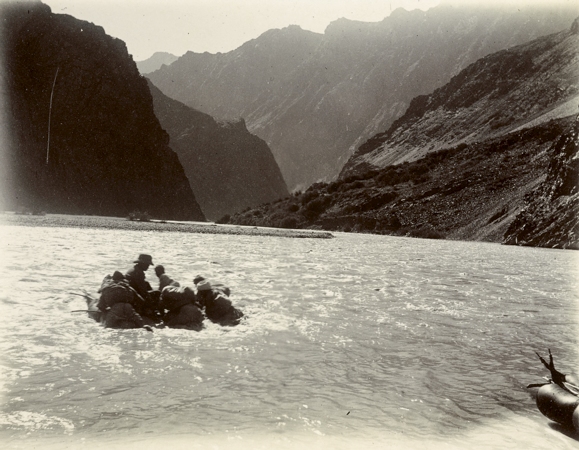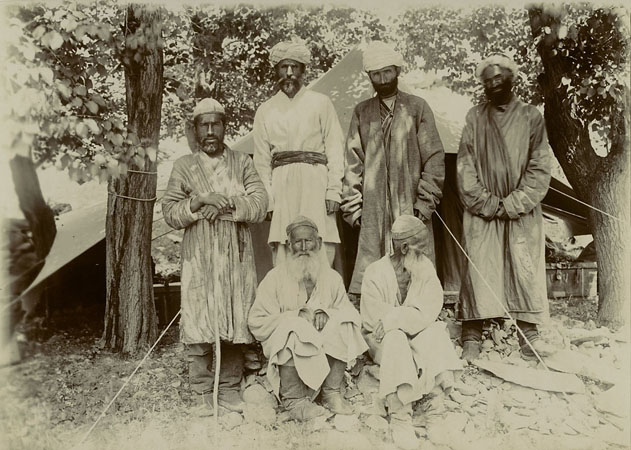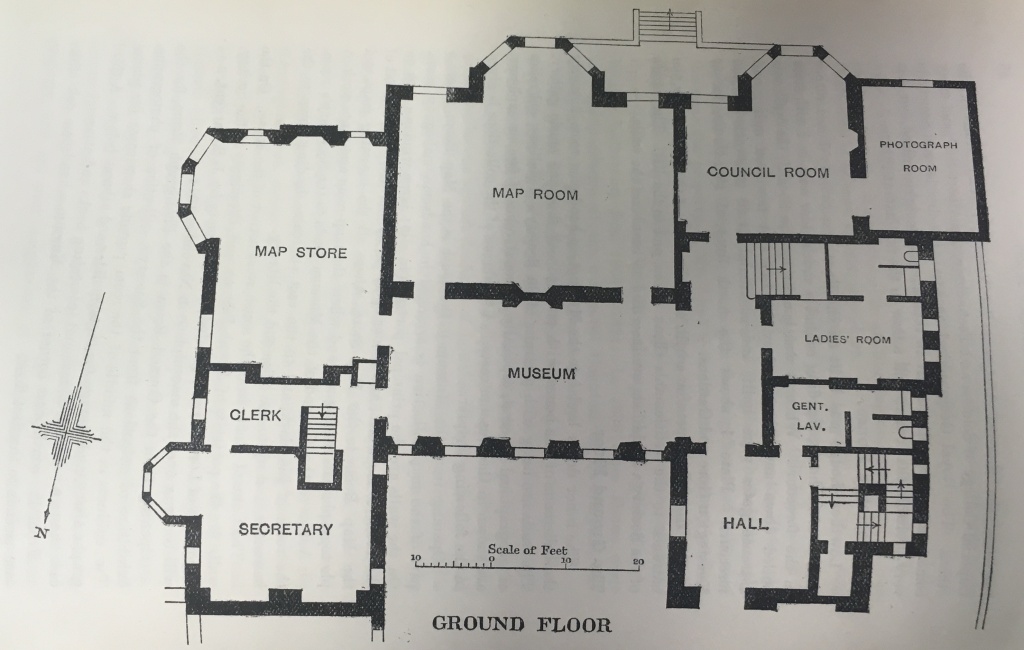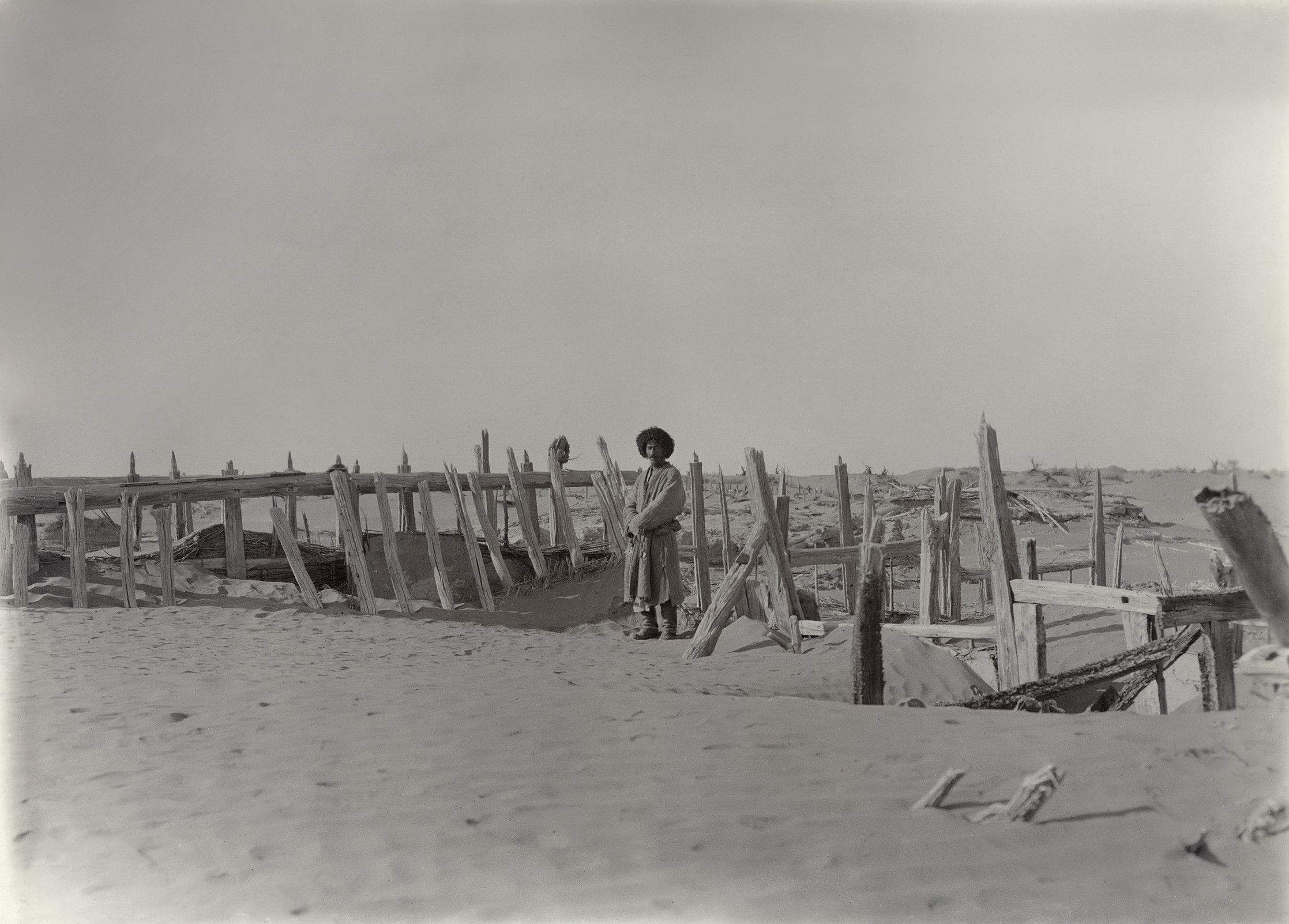Planning and preparation
On June 5, 1916, Stein gave a lecture at the Royal Geographical Society, located since 1913 at Lowther Lodge in Kensington, its present home.1 The lecture was entitled ‘A Third Journey of Exploration in Central Asia, 1913–16’ and was illustrated with lantern slides.2 Following this, Stein notes in a letter to Fred Andrews that ‘It is probable we shall have a photographic exhibition of selected photos at the R.G.S.; specifically enlarged prints are to be prepared for this purpose from selected negatives.’ [MSS Stein 43/116-7, 22 June 1916]3
His lecture was published in two parts, with maps and 31 photographs (several of them mountain panoramas), in the August and September issues of the Geographical Journal [48.2: 97-130 and 48.3: 93-229], followed by a transcript of the discussion with comments by Austen Chamberlain, Hercules Read, Francis Younghusband, Henry Trotter, C. E. Yate and Dr. Lionel Barnett [48.3: 225-9]. Stein’s next letter to Andrews in August notes that the article is going to press and that ‘Arrangements for the exhibition at the R.G.S. of enlargements are proceeding with Leman.’ [MSS Stein 43/144–5] In another letter in August he continues ‘We are now arranging for an exhibition of enlarged photographs for display in the Geog. Soc.’s Photographic Room. Leman has done some excellent specimens up to 22″ in length, and if only more negatives were available here we could easily fill many times the number of cases which are actually available.’ [MSS Stein 43/163-5].

The British Library Photo 392/28(950).
Herbert Thomas Leman was an established London photographer based in Regent Street but, despite this positive assessment of the enlargements by Stein, Arthur Hinks, RGS Secretary, was not so impressed. Stein, who was writing up his report in his Devon retreat of Middlecott, had arranged for the first batch of Leman’s enlargements to be sent to Hinks in March 1917 and noted that he planned to be in London later that month and could visit the RGS if necessary. Hinks responds on 6th March:
If you are able to come in one day this week I shall be glad to talk to you about the enlargements which your photographer has made. I notice that they are completely untouched and that all the defects of the negatives are still there. Doubtless you refuse to allow any touching of your negatives, but I still think we shall have to do something to remove these blemishes before the photographs are suitable for exhibition. I shall be glad to have a word with you on the subject. [CB8/2 6/3/1917]
The result of their conversation is unclear but Leman continued to produce the enlargements, the second set at a smaller size. Meanwhile, Mr Simpson was working on producing panoramic prints from Stein’s sets of photographs. In early May, Stein writes to Hinks to inform him that a further 37 enlargements from Leman have been sent and that ‘I hope, the great majority will be found acceptable.’ [CB/8 4/5/17] Stein makes another visit to London later in the month where he is shown the results of Simpson’s work on the panoramas. This clearly changes his opinion of Leman’s work as, in Stein’s letter to Hinks on his return to Devon, he writes: ‘I hope, Mr Simpson has been able to arrange for more satisfactory enlargements of my photographs for the proposed exhibition. The contrast between those he made himself of the panoramic views and those supplied by Leman is, alas, only too striking.’ [CB/8 1/6/1917] Hinks replies:
‘I am going into the question of the photographs, and hope to write to you in a day or so. I think there is no doubt that you will have to authorise the transfer of your negatives to somebody else, but I doubt if Simpson could get them done very quickly, and it might be better to get them from Ross or the Stereoscopic Co., both of whom do good work. The only question will be what to do about the payment of your own photographer who has failed so lamentably, and I will discuss that with you when I see you next.’ [CB/8 4/6/1917]
We know from subsequent correspondence that the negatives were transferred to Ross Co. The RGS originally assigned £10 for the enlargements. We do not know how much of this Leman was paid but Hinks suggests that they will ‘have to pay your failure some pounds for his failure, but I should certainly object to paying him in full.’ [CB/8 29/6/1917]

The British Library, Photo 392/29(388).
Stein sees some of the enlargements from Ross in London on his way to his return to India. Florence Lorimer, Stein’s assistant at the British Museum, continues the correspondence with Hinks, asking when the exhibition is due to open, for three dozen invitations to send to Stein’s friends in London, and for return of the negatives. [CB/8 3/11/1917] Hinks returns all the negatives by the year end and, in reply to Lorimer’s acknowledgement, explains that the exhibition was delayed owing to ‘the impossibility of getting hold of any suitable paper for the mounts. We have done our best, however, and the thing is just about to start.’ [CB/8 14/1/1918] The shortage of suitable paper was most probably a result of the war and accounts for the green card which was used rather than a more usual cream.
Lorimer keeps Stein informed: she writes to him on Wednesday 30 January 1918 that ‘The Exhibition is to be open at the end of this week. I have written to Dr Hinks for the notices, but they have not come yet. The negatives have all been returned; and I shall send you a list when I have made out that all orig. sent to the Geog. Soc. are there.’ [MSS Stein 44/90] Her letter dated 13 February confirms that ‘The R.G.S. invitations came and I sent them out to about two dozen of your friends. I have not time to go to the Exhib. yet myself, but I am taking a friend next week.’ [MSS Stein 44/92].
I have not yet been able to find out when the exhibition ended.
The Exhibition
The Exhibition was held in the Photographic Room of the RGS at Lowther Lodge. In 1913 this was the rectangular room adjoining the Council Room—see plan below—today used as the kitchen adjoining the tea room.

Hinks explains to Stein that:
‘The unit of space in our exhibition cases is a panel 28” wide by 21.5” high. This takes 9 prints 7.5” wide by 5” high (commercial size;) it gives good proportions for landscapes); or it takes 4 prints about 10” wide by 8” high, or one print about 22” wide by 15” high. Now, probably in your collection you have a few pictures which it would be worth enlarging to the largest size, a number more that would be worthily represented on the 10” x 8” size, and a still larger number for which the 7.5” x 5” would be sufficient.’ [CB/8 1/8/1916].
I have not been able to discover how many exhibition cases there were in the room, nor find a list of exhibits, but the RGS archives include the following number of enlargements of Stein photographs, all of which are distinguished not just by their size but also by the fact they are mounted on a pale green card and have captions written in pencil below in the same hand (not Stein’s). It is a reasonable assumption that these were the exhibits. These would have required about 22 panels in the exhibition cases, according to Hinks’s measurements above. A list is given below, by the RGS number, with the corresponding British Library Photo. no. and link, and the fig. no. if it was published in either Stein’s article in the Geographical Journal (GJ) or in Innermost Asia (IA).
41 prints in total
10 prints @ c.22″ x 17″ mounted on card c. 23″ x 18″
5 prints @ c.16″ x 12″ mounted on card c. 23″ x 18″
17 prints @ c.8″ x 10″ mounted on card c. 10″ x 12″
9 prints @ c.6″ x 7.5″ mounted on card c. 10″ x 12″

The British Library Photo 392/29(58).
List of Exhibits
| RGS no. | size/ins | BL no. | GS/IA fig. no. | Caption on exh. print |
|---|---|---|---|---|
| X0794/ 025406 | 12 x16.5 | Photo 392/29 (392) | /372 | New Sarez Lake from west slope, Yerkh inlet. |
| X0794/ 025407 | 16.5 x 12 | Photo 392/29 (406) | 26/393 | Oxus valley with Hindukush peaks above Darra-i-Panja, seen from ruined fort above Zang (view to south-east). |
| X0794/ 025408 | 12 x 16 | Photo 392/29 (386) | /370 | Down Bartang River gorge, Roshan, from Saunab. |
| X0794/ 025409 | 12 x 16 | Photo 392/28 (987) | /447 | Glacier east of Gardan-i-Kaftar Pass, Darwaz, from about 12,300 feet. |
| X0794/ 025410 | 12 x 16 | Photo 392/29 (391) | 23/372 | Bartang River gorge above Barchidiw, blocked by Sarez earthquake: new lakelet in foreground. |
| X0794/ 025411 | 23 x 17 | Photo 392/29 (335) | 21/362 | Glacier range between Mukso and Sel-darra (Fedshenko Glacier) from Tarsagar pass (circ. 11,500 feet). |
| X0794/ 025412 | 23 x 17 | Photo 392/29 (381) | 24/373 | Earthquake barrage blocking Sareg Valley with west end of new lake fed by Bartang River from 3000 feet above 1915 level of lake. |
| X0794/ 025413 | 23 x 17 | Photo 392/28 (140) | [5]/50 | Darkot Glaciers and Koyozum Peak from Karambar saddle (circ. 14,000 feet). |
| X0794/ 025414 | 23 x 17 | not yet identified | [5]/49 | End of Karambar Glacer from near Karambar saddle. |
| X0794/ 025415 | 17 x 23 | Photo 392/28 (133) | 3/52 | Chillinji glacier, looking west across Karambar (Ashkuman) river. |
| X0794/ 025416 | 22 x 17 | Photo 392/29 (453) | 25/392 | Junction of Ab-i-Panja branch of Oxus with Great Pamir River from above Langar-Kisht: Hindukush watershed in background. |
| X0794/ 025417 | 25 x 17 | Photo 392/29 (288) | /43 | North Glacier of Darkot from below Darkot Pass: Mastujis in foreground. |
| X0794/ 025418 | 23 x 16.5 | Photo 392/29 (440) | Glacier and moraines below Shitam Pass. Shughnan, at circ. 17,500 feet, looking south. | |
| X0794/ 025419 | 23 x 16.5 | Photo 392/29 (297) | 20/364 | Head of Bostan-Arche valley, looking N.W. towards glacier peaks of Ulugh-art range: surveyor Afrazgul and “Dash III” in foreground. |
| X0794/ 025420 | 23 x 17 | not yet identified | /456 | Ruins of Buddhist site on slope of Koh-i-khwaja, with view eastwards across terminal Helman marshes, Seistan. |
| PR/ 027849 | 7.75 x 5.75 | Photo 392/28(950) | /442 | Skin raft in gorge of Bartang River, Roshan, above Padrun. |
| PR/ 027850 | 10 x 8 | Photo 392/29(461) | Victoria Lake, Great Pamir, looking south towards Nicholas Range. | |
| PR/ 027851 | 7.5 x 6 | Photo 392/28(842) | Tachta-Korum Pass, between Sel-darra and Great Kara-kol drainage, Pamirs. | |
| PR/ 027852 | 10 x 8 | Photo 392/28(828) | /367 | Chukur Jilga glacier, near headwaters of Sel-darra. |
| PR/ 027853 | 10 x 8 | Photo 392/28(957) | /394 | Adude Glacier with pass (circ. 15,500 feet), between Roshan and Yazghulam valleys, Upper Oxus. |
| PR/ 027854 | 10 x 8 | not yet identified | /360 | Across west of Great Pamir towards Nicholas Range. |
| PR/ 027855 | 10 x 8 | Photo 392/29(399) | Yeshil-Kol lake, Pamirs, looking west from mouth of Kichik Marjanai V. | |
| PR/ 027856 | 7.5 x 6 | Photo 392/28(878) | Outflow of Great Pamir river below Lake Victoria, looking south towards Shor Jilga of Nicholas Range. | |
| PR/ 027990(A) | 10 x 8 | Photo 392/29(388) | 22/366 | Headmen of uppermost Roshan balley at Saunab (Tashkurghan): type of Homo Alpinus. |
| PR/ 028045 | 10 x 8 | Photo 392/29(415) | 28/411 | West ramparts and towers of ancient fortress, Kala-i-kala, near Namadgut, Wakhan. |
| PR/ 029492 | 10 x 8 | Photo 392/29(59) | 10/132 | Remains of orchard with vine trellis (3rd century A.D.), Niya site, Takla-Makan desert. |
| PR/ 029493 | c.7.5 x 6 | Photo 392/29(58) | /97 | Sand buried ruin of house (N.III) of 3rd century A.D., Niya site, before excavation. |
| PR/ 029494 | 7.5 x 5.5 | Photo 392/28(177) | /77 | Kirghiz with felt tents (Ak-ois) below Merki Pass, Mustagh-Ata Range. |
| PR/ 029495 | c.7.5 x 6 | Photo 392/29(98) | 15/181 | Salt bog within easternmost bay of Lop sea. |
| PR/ 029496 | c.7.5 x 6 | Photo 392/28(433) | /179 | Crossing hard salt encrusted bed of Lop sea. |
| PR/ 029497 | c.7.5 x 6 | Photo 392/28(419) | 14/164 | Wind-eroded clay terrace with ancient remains, Lop desert, N.W. of Lou-lan site. |
| PR/ 029498 | c.7.5 x 6 | Photo 392/28(231) | Approach to high range of dunes near Chok-Tagh, south of Maralbashi | |
| PR/ 029499 | 10 x 8 | Photo 392/29(210) | 19/315 | Ruins of Buddhist cave temples (7th-9th century A.D.) below Murtuk, Turfan. |
| PR/ 029500 | 10 x 8 | Photo 392/28(385) | 11/142 | Wind eroded clay terraces (yardangs) with debris of ancient trees, south-west of Lou-lan site, Lop desert. |
| PR/ 029501 | 10 x 8 | Photo 392/28(430) | /174 | March between salt-encrusted clay ridges (White Dragon mounds) north of Lop sea. |
| PR/ 029502 | 7.5 x 5.5 | Photo 392/28(452) | 16/200 | Ancient Chinese border wall (circa. 100 B.C.) of layers of clay and reed fascines, near watch-tower T.XIII., Tun-huang. |
| PR/ 029503 | 7.5 x 5.5 | Photo 392/28(170) | 4/55 | Camels descending gorge of Kara-tash River, Muztagh-ata Range. |
| PR/ 029504 | 10 x 8 | Photo 392/29(101) | /183 | Camels halting below clay cliffs of old shore line, easternmost bay, Lop Sea. |
| PR/ 029505 | 7.5 x 5.5 | Photo 392/28(307) | /102 | Foot-bridge (3rd century A.D.) across dried river bed, Niya site, Takla-Makan desert. |
| PR/ 029506 | 7.5 x 5.5 | Photo 392/29(259) | /327 | Ruins in Yar-Khoto, ancient capital of Turfan: substructures excavated from loess; superstructures in stamped clay. |
| PR/ 029507 | 7.5 x 5.5 | Photo 392/29(184) | /311 | Buddhist cave shrines in Toyuk Gorge, Turfan. |
| PR/ 029508 | 10 x 8 | Photo 392/28(205) | /69 | North-east from summit of Merki Pass Muztagh-ata range. |
| PR/ 029509 | 7.5 x 5.5 | Photo 392/28(249/a) | 7/89 | High drift sand ridges, Takla-Makan desert, towards Mazar-tagh. |
| PR/ 029510 | 10 x 8 | Photo 392/29(152) | /246 | Walls of Kara-Khoto (Marco Polo’s “Etzina”) near Etsingol Southern Mongolia, breached by wind erosion. |
| PR/ 030724 | 7.5 x 6 | Photo 392/28(148) | Moraine of Chillinji Glacier, Guhyal, above Biattar, with ‘Wakhi carriers.’ | |
| PR/ 030725 | 7.5 x 5.5 | Photo 392/28(132) | /60 | Snout of glacier blocking headwaters Karambar R. below Rukhni. |
| PR/ 030726 | 10 x 8 | Photo 392/28(145) | 8/61 | Glacier snout blocking Karambar valley above Sukhta-rabat, Ashkuman [Ishuman] (Gilgit A). |
| PR/ 030727 | 7.5 x 5.5 | Photo 392/28(13) | Barai velley from below Mori, Khel, Kashmir. | |
| PR/ 030728 | 7.5 x 5.5 | Photo 392/29(27) | /42 | Khushwakt headmen with villagers at Hondur, Yasin. |
| PR/ 030729 | 10 x 8 | Photo 392/28(60a/b) | From Nyachut towards head of Darel Valley: Afrazgul and Shah Alim in foreground. | |
| PR/ 030730 | 10 x 8 | Photo 392/29(9) | From Dalgin Apl, Darel, towards Ishkobar Pass. |
Biographical notes
From Kelly’s Directory for London and Michael Pritchard, A Directory of London Photographers 1841-1908 (Watford: PhotoResearch, 1994).
John Scott Keltie (1840–1927) was Secretary of the R.G.S. from 1896 to 1915, when he was succeeded by Hinks. He was also President from 1914-1915 and co-editor of the Journal with Hinks until 1917.
Arthur Robert Hinks (1873–1945) was Secretary of the R.G.S. and editor of the Journal, posts he held from 1915 until his death.
Herbert Thomas Leman, 304 Regent St, London. The photographer was registered at this address in the 1921 Kelly’s Directory. Before this it was at 135 Oxford Street W, active from 1899–1902.
London Stereoscopic Co.; 3 Hanover Sq, London.
Ross Ltd, 3 Albermarle St., St John’s Sq., London.
Simpson: I have not been able to identify Mr Simpson who worked on Stein’s panoramas. I hope someone out there can help.
Notes
- The lecture had been suggested by John Keltie, RGS Secretary in a letter to Stein on 20 September 1915 (RGS CB8/2) and the date was arranged between Stein and the succeeding RGS Secretary, Arthur Hinks, following this. Stein confirms the date in a letter to Hinks of 10 January 1916, written while he was excavating at Seistan, Iran. Dinner guests and discussants were agreed in subsequent letters. For more on the Society’s move into Lowther Lodge see their pdf.
- Lantern slides were prepared by Stein in London from negatives he had carried to London. A collection of 1190 such slides of Stein’s photographs was given to the British Library by the R.G.S. in 1974 (British Library, Photo 392/56).
- Archives referred to are the Aurel Stein papers in the Bodleian Library, Oxford (prefixed MSS Stein) and the Aurel Stein correspondence in the RGS (prefixed CB).
Acknowledgements
Many thanks to Eugene Rae, Principal Librarian at the RGS, for his help.